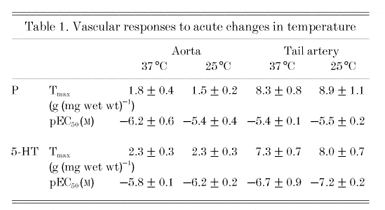The maximum force generated by vascular smooth muscle (VSM) in response to exogenous noradrenaline decreases on moderate cooling from 37 °C to 15-25 °C in a wide range of mammalian blood vessels (Vanhoutte, 1980). Superficial vessels would ordinarily be exposed to a reduced environmental temperature compared with deeper vessels, and often show a potentiation of contractility upon a similar degree of cooling (Vanhoutte & Flavahan, 1986). We therefore examined whether anatomical location may influence how VSM contractility varies in response to acute alterations of temperature, and determined whether the thermosensitive properties of vessels can be altered by long-term exposure to lowered environmental temperature.
Male Wistar rats, 300-400 g (n = 10 normothermic, n = 8 cold-acclimated), were humanely killed by cervical dislocation in accordance with UK legislation. Normothermic animals were held at 20 °C and 12 h light:12 h dark photoperiod, with access to food and water ad libitum. Cold-acclimated rats were exposed to progressively lower environmental temperature (20 °C to 4 °C) and photoperiod (12 h to 1 h light day-1) over 8 weeks. Acute thermosensitivity of isolated segments of aorta and ventral tail artery was assessed by the change in maximum contractile response (Tmax), as measured by an isometric myograph, to exogenous noradrenaline (NAd), phenylephrine (PE) and serotonin (5-HT) at 25 and 37 °C, and pEC50 calculated to determine the effect of temperature on vessel sensitivity. Data (means ± S.E.M.) were analysed using ANOVA and significance taken at P < 0.05.
Both Tmax and pEC50 of tail artery segments exposed to PE were unaffected by acute temperature change (Table 1) or cold acclimation (data not shown). Qualitatively similar data were obtained with NAd. Rings of aorta showed decreased contractile response and sensitivity at the lower temperature, but remained similarly unaffected by acclimation. When exposed to 5-HT the tail artery showed a similar pattern to that with PE. However, acute cold exposure increased 5-HT sensitivity but not Tmax in aorta, while cold acclimation was without any significant effect. The functional consequence of vessel thermosensitivity may depend both on location and size, e.g. in vivo studies showed that impairment of terminal arteriole vasoconstriction by acute cooling was reversed after cold acclimation (Brown et al. 1993).

